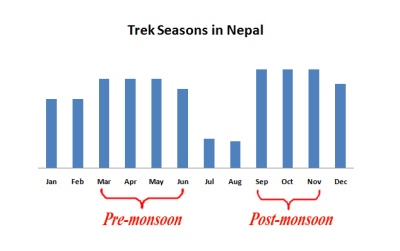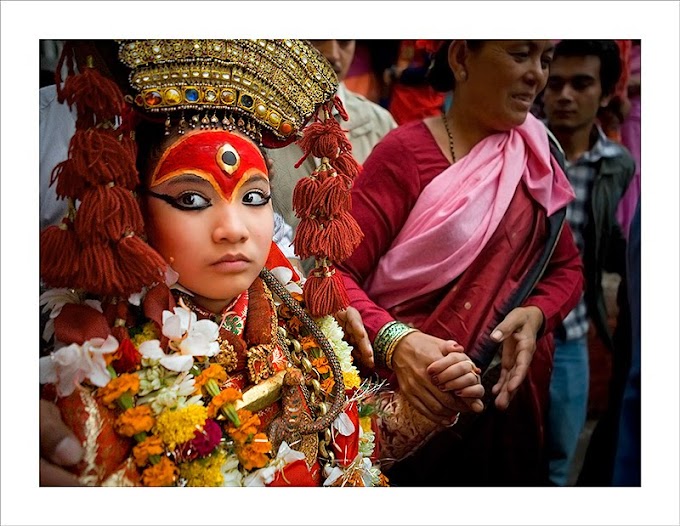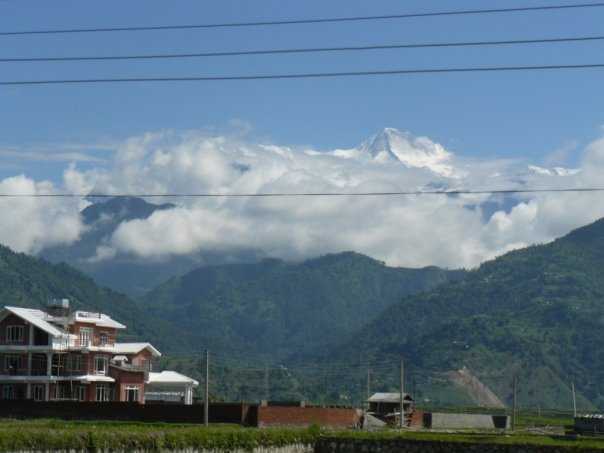More than 50,000 trekkers make a point to visit Everest region every year. The popular Everest base camp trek
attracts adventure enthusiasts from around the world. Equally
intriguing but least traveled regions of the Everest are its 3 high
passes; Renjo La, Cho La and Kongma La, respectively. Here, you will cross some of the highest passes in the world, along with traversing the greater Khumbu valley.
Crossing high passes is considered an ordeal, which toughens you
physically and mentally by showering upon you its harsh weather and
unmerciful terrains. However, if you wish to trek the high passes, then
there isn’t any treks in the world as adventurous as this!
∞Overview∞
Everest’s 3 passes are some of the highest passes in the
whole world. Located at close proximity to Everest, the 3 passes require
more time, skill and strength to explore the entire region.
Encountering the uneven terrains, sea of snow and ice and bitter cold is
common.
One must be accompanied with a guide during the trek, as the region still consists of unbeaten tracks. The wider and barren landscape, most of the times, is taken as a Ghostly town.
#1 Renjo La
 |
| Chukhung valley seen from the Renjo La |
Renjo La is one of the high passes located in Khumbu
valley at an elevation of 5,360 m (17,585 ft). It follows the path
leaving Gokyo to the west and is in the eastern front of Lungden.
The path to Renjo La is quite strenuous; snowfall during winter makes
it difficult to attempt the pass. Renjo La and surrounding regions are
culturally Tibetan. Enjoying close panorama of some of the highest
mountains in the wold is the major attraction of the trek. Through Renjo
La, you can reach the exquisite valley of Gokyo and make your way
further west to Cho La Pass.
#2 Cho La
 |
| Cho La Pass 5,420 m (17,782′) at khumbu is one of the highest pass in the world, also connecting Gokyo valley with Khumjung |
Cho La 5,420 m (17,782 ft) is a high pass located along Gokyo
trail in Khumbu valley. It connects the village of Dzongla to the east
and the village of Thagnak to the west.
One can cross Ngozumpa glacier on the way to Cho La. To the east the trail joins the classic Everest Base Camp route.
Ascending Cho La can be physically demanding and may require crampons
for slippery paths. One can get best view of Lobuche peak from the top.
#3 Kongma La
Kongma La 5,535 m (18,160 ft) is another high pass
located between Chukhung village and Lobuche. Trekkers can attempt
Kongma La on a return route from the base camp.
It is the highest pass among 3 Everest passes. The panorama of surrounding mountains is quite amazing when seen from Kongma La.
∞Map & Trek Seasons∞

Pre-monsoon (March-June) and Post-monsoon (September-November) are
two of the great seasons for trekking in Khumbu valley. The weather is
clear; days are warm and nights are cold.The higher regions and passes
may receive snowfall during post-monsoon and winter.
∞Standard Itinerary∞
Day 01: Fly to Lukla (2,800 m/9,186 ft) & trek to Phakding (2,652 m/8,700 ft), 3-4 hrs walk
Day 02: Phakding to Namche Bazaar (3,440 m/11,283 ft), 5-6 hrs walk
Day 03: Acclimatization day at Namche Bazaar
Day 04: Trek to Thame, (3,800 m), 3 to 4 hours
Day 05: Trek to Marlung, (4,137 m), 4 to 5 hours
Day 06: Trek to Lungdeng (4,600 m), 3 to 4 hours
Day 07: Trek to Renjo- La (17,929 ft?5465 m) to Gokyo Lake (4,800 m)
Day 08: Relax Day at Gokyo Lake
Day 09: Hike to Gokyo RI (5,330 m/17,483 ft), and trek to Thaknak (4,750 m/15,580 ft), 6-7 hrs walk
Day 10: Trek to Cho-la Pass (5,367 m/17,604 ft) to Dzongla (4,850 m/15,908 ft), 5-6 hrs walk
Day 11: Trek to Gorakshep (5,160 m/16,929 ft), 5-6 hrs walk
Day 12: Trek to Everest Base Camp (5,357 m/17,575 ft) and return to Lobuche for overnight. 6 to 7 hrs
Day 13: Lobuche – Kongma La (5,535 m/18,159 ft) – Chhukung (4,730 m/15,518 ft): 6-7 hrs
Day 14: Trek to Tyangboche (3,867 m/12684 ft), 4-5 hrs walk
Day 15: Trek to Monjo ((2680 m/8,791 ft), 5-6 hrs walk
Day 16: Trek to Lukla (2,800 m/9,186 ft), 6-7 hrs walk
∞Montage∞
∞Gears & Equipment∞
- Pair of hiking boots (well broken in) – One could spend over 5 to 6 hours a day on the trail, therefore, long-lasting boots are essential. The boots can range from light to medium, high or low. If one plans to trek during the months when it snows, the high boots become essential for proper hiking.
- Soft and light shoes (sneakers) – Carrying light-weight sneakers for ‘after the day hike’ serves comfort.
- Crampons – it may become essential to carry crampons along because the high passes and the surrounding are quite difficult terrains with snow and ice covering the field. Using crampoon during the ascent may help climb easier.
- Lightweight knapsack - It is useful for short trips away from one’s lodge, and will save you from carrying large backpack along. It should be large enough to fit a camera, spare clothes and a sleeping bag, if one plans to spend a night away.
- Lightweight sleeping bag - Essential during peak seasons (October-December). Lodges do offer blankets, but are scarce during the peak season, therefore carrying a sleeping bag (-10 C°) can be a great precaution.
- Fabric band-aids - Blisters are common due to rigorous walking. A good alternative to band-aids is duct tape. Works great for blisters and also proves invaluable in many other ways.
Costs & Permits
The permit cost for entering Sagarmatha National Park (UNESCO Heritage Site) is:
- SAARC Nationals – Rs. 1,500 per person (Approx. US $15)
- Non-SAARC Nationals – Rs. 3,000 per person (Approx. US $30)
Resources
- Everest 3 Passes Trek -21 Days
- Gokyo Valley Trek -14 Days










Everest 3 High Pass Trekking
ReplyDeleteThis is one of the difficult treks in Everest Region. Crossing three spectacular high passes between 5,330m and 5,535m, spectacular mountain views makes this trek both challenging and rewarding that will leave with memories to cherish all lifelong.
Highlights:
Ultimate circuit of adventure in the Everest Region, which includes Everest Base Camp
Crossing three of Nepal’s highest trekking passes - all over 5,300m in Himalayas
Ascending Kala Pathar 5445m and Gokyo Ri 5350 m for magnificent panorama views of some of the world’s eight-thousands mountains
Soaking up the tranquility of Gokyo’s sacred lakes
Immersing in Buddhist culture and enjoying Sherpa
• Standard Option
Live guide: English
Duration: 20 days, Private tour
Starts at meeting point, pick-up at hotel possible
from $ 2100.00(per person)
________________________________________
http://www.nepalguideinfo.com/Everest-Base-Camp.php
http://www.hikehimalayas.com/trekking-in-nepal/trekking-region/everest-region/everest-base-camp.htm
http://www.nepalguideinfo.com
Email-:sanjib-adhikari@hotmail.com
https://www.facebook.com/sanjib.adhikari
Mobile+9779841613822
Your information about tour packages is really interesting. Also I want you to share some updated news about the tour packages. Can you update in your website? Thanks for sharing this informative article.
ReplyDeleteKerala tour package
Your information about tour packages is really interesting. Also I want you to share some updated news about the tour packages. Can you update in your website? Thanks for sharing this informative article.
ReplyDeleteKerala tour package
very nice… i really like your blog…thanks for sharing this with us.
ReplyDeleteEverest Base Camp Trek 14 days
Annapurna Base Camp Trek 13 days
Great article. Couldn’t be write much better! Keep it up!
ReplyDeleteAnnapurna Base Camp Trek-10 Days
Mustang Valley Trek-17 Days
I’m really happy to say it was an interesting post to read. I learned new information from your article, you are doing a great job. Keep it up.
ReplyDeleteClassic Trek to Everest Base Camp via Jiri-22 Days
Everest High passes trek-20 days
Really very awesome information site it is. It gives much collection of information of all world tours and tips. This guidance helps everyone who wants to travel in any other place of world. Great work.
ReplyDeleteTrekking in Mustang Region
Upper Mustang Trek
Thank you for such a detail information about Everest High Passes Trek.
ReplyDelete